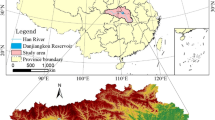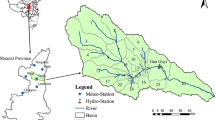Abstract
A clear understanding of the relationships among multiple ecosystem services (ESs) is the foundation for sustainable urban ecosystem management. Quantitatively identifying the factors that influence ES trade-offs and synergies can contribute to deepening ES research, from knowledge building to decision making. This study simulated soil conservation, water yield and carbon sequestration in Bei**g, China, from 2015–2018. The spatial trade-offs and synergies of these three ESs within the five major river basins in Bei**g were explored using geographically weighted regression. Furthermore, geographical detector was applied to quantitatively identify the driving mechanism of the environmental factors for the ES trade-offs and synergies. The results show the following: (1) the spatial relationships between soil conservation and water yield, as well as between water yield and carbon sequestration, were mainly trade-offs. There was a spatial synergy between soil conservation and carbon sequestration. (2) Regarding the spatial trade-off/synergy between soil conservation and water yield in Bei**g, the dominant influencing factor was temperature/elevation, and the dominant interactions of the spatial trade-off and synergy between these two ESs in Bei**g and the Chaobai River Basin are all manifested in the superposition of precipitation and potential evapotranspiration, temperature, and elevation. (3) Topographic factors were the dominant factors influencing the spatial relationship between soil conservation and carbon sequestration in Bei**g and its five major river basins. As a result of the distribution of water systems and hydrological characteristics of the basins, differences were observed in the effects of different combinations of interaction factors on the spatial relationship between these two ESs in different basins. (4) Temperature had the strongest explanatory power in terms of the spatial trade-offs and synergies between water yield and carbon sequestration. The interactions between precipitation and temperature and between precipitation and elevation were the dominant interactions affecting the spatial relationship between water yield and carbon sequestration in Bei**g. Overall, the explanatory power of influencing factors on the trade-offs and synergies and the degree of interaction between factors coexist in different basins with consistency and differences. Therefore, understanding the quantitative characteristics of basin-scale spatial trade-offs and synergies between ESs is important for ecosystem management and the promotion of synergy in different basins.
Similar content being viewed by others
References
Bai Y, Ouyang Z Y, Zheng H et al., 2012. Modeling soil conservation, water conservation and their tradeoffs: A case study in Bei**g. Journal of Environmental Sciences, 24(3): 419–426.
Bai Y, Zhuang C W, Ouyang Z Y et al., 2011. Spatial characteristics between biodiversity and ecosystem services in a human-dominated watershed. Ecological Complexity, 8(2): 177–183.
Bennett E M, Peterson G D, Gordon L J, 2009. Understanding relationships among multiple ecosystem services. Ecology Letters, 12: 1394–1404.
Brunsdon C, Fotheringham A S, Charlton M, 1996. Geographically weighted regression: A method for exploring spatial nonstationarity. Geographical Analysis, 28(4): 281–298.
Brunsdon C, Fotheringham A S, Charlton M, 1998. Geographically weighted regression: Modelling spatial non-stationarity. Journal of the Royal Statistical Society. Series D: The Statistician, 47(3): 431–443.
Crabtree R, Potter C, Mullen R et al., 2009. A modeling and spatio-temporal analysis framework for monitoring environmental change using NPP as an ecosystem indicator. Remote Sensing of Environment, 113(7): 1486–1496.
Dade M C, Mitchell M G E, McAlpine C A et al., 2019. Assessing ecosystem service trade-offs and synergies: The need for a more mechanistic approach. AMBIO A Journal of the Human Environment, 48: 1116–1128.
Dai E F, Wang X L, Zhu J J et al., 2016. Methods, tools and research framework of ecosystem services trade-offs. Geographical Research, 35(6): 1005–1016. (in Chinese)
Daily G C, 1997. Nature’s Services: Societal Dependence on Natural Ecosystems. Washington DC: Island Press.
Egoh B N, Reyers B, Rouget M et al., 2011. Identifying priority areas for ecosystem service management in South African grasslands. Journal of Environmental Management, 92(6): 1642–1650.
Feng T, Chen H S, Polyakov V O et al., 2016. Soil erosion rates in two karst peak-cluster depression basins of northwest Guangxi, China: Comparison of the RUSLE model with 137Cs measurements. Geomorphology, 253: 217–224.
Fotheringham A S, Brundson C, Charlton M, 2002. Geographically Weighted Regression: The Analysis of Spatially Varying Relationships. New York: Wiley.
Fu B P, 1981. On the calculation of the evaporation from land surface. Chinese Journal of Atmospheric Sciences, 5: 23–31. (in Chinese)
Gao J B, Jiang Y, Wang H et al., 2020. Identification of dominant factors affecting soil erosion and water yield within ecological red line areas. Remote Sensing, 12(3): 399.
Gao J B, Li S C, Zhao Z Q et al., 2012. Investigating spatial variation in the relationships between NDVI and environmental factors at multi-scales: A case study of Guizhou Karst Plateau, China. International Journal of Remote Sensing, 33(7): 2112–2129.
Gao J B, Wang H, Zuo L Y, 2018. Spatial gradient and quantitative attribution of karst soil erosion in Southwest China. Environmental Monitoring and Assessment, 190(12): 730.
Holling C S, Meffe G K, 1996. Command and control and the pathology of natural resource management. Conservation Biology, 10(2): 328–337.
Huang J C, Fang C L, 2003. Analysis of coupling mechanism and rules between urbanization and eco-environment. Geographical Research, 22(2): 211–220. (in Chinese)
Hubacek K, Guan D, Barrett J et al., 2009. Environmental implications of urbanization and lifestyle change in China: Ecological and water footprints. Journal of Cleaner Production, 17(14): 1241–1248.
** H C, 2001. Soil and water loss in Bei**g and its prevention. Research of Soil and Water Conservation, 8(4): 154–157. (in Chinese)
Leh M D K, Matlock M D, Cummings E C et al., 2013. Quantifying and map** multiple ecosystem services change in West Africa. Agriculture Ecosystem and Environment, 165: 6–18.
Li S C, Zhang C Y, Liu J L et al., 2013. The tradeoffs and synergies of ecosystem services: Research progress, development trend, and themes of geography. Geographical Research, 32(8): 1379–1390. (in Chinese)
Liu Y, Bi J, Lv J S, 2019. Classification of ecosystem services and a reclassification framework of watershed ecosystem services. Resources Science, 41(7): 1189–1200. (in Chinese)
Markus P, 2002. Technical progress, structural change, and the environment Kuznets curve. Ecological Economics, 42(3): 381–389.
Mohamed M A, Babiker I S, Chen Z M et al., 2004. The role of climate variability in the inter-annual variation of terrestrial net primary production (NPP). Science of the Total Environment, 332(1): 123–137.
Peng J, Hu X X, Zhao M Y et al., 2017. Research progress on ecosystem services trade-offs: From cognition to decision-making. Acta Geographica Sinica, 72(6): 960–973. (in Chinese)
Rodríguez J P, Beard T D J, Bennett E M et al., 2005. Trade-offs across space, time, and ecosystem services. Ecology and Society, 11(1): 709–723.
Sharp R, Tallis H T, Ricketts T et al., 2016. InVEST + VERSION + User’s Guide. The Natural Capital Project, Stanford University, University of Minnesota, The Nature Conservancy, and World Wildlife Fund. Stanford (CA): Stanford University.
Shen J S, Li S C, Liang Z et al., 2020. Exploring the heterogeneity and nonlinearity of trade-offs and synergies among ecosystem services bundles in the Bei**g-Tian**-Hebei urban agglomeration. Ecosystem Services, 43: 101103.
Su C H, Fu B J, 2013. Evolution of ecosystem services in the Chinese Loess Plateau under climatic and land use changes. Global and Planetary Change, 101: 119–128.
Tang T, Ran S H, Tan M H, 2013. Urbanization and its impact on the evapotranspiration in Bei**g-Tian**-Tangshan area. Journal of Geo-Information Science, 15(2): 233–240. (in Chinese)
Wang J F, Hu Y, 2012. Environmental health risk detection with GeogDetector. Environmental Modelling and Software, 33: 114–115.
Wang J F, Li X H, Christakos G et al., 2010. Geographical detectors-based health risk assessment and its application in the neural tube defects study of the Heshun region, China. International Journal of Geographical Information Science, 24(1): 107–127.
Wang J F, Xu C D, 2017. Geodetector: Principle and prospective. Acta Geographica Sinica, 72(1): 116–134. (in Chinese)
**ao Y, An K, Yang Y et al., 2014. Forest carbon storage trends along altitudinal gradients in Bei**g, China. Journal of Resources and Ecology, 5(2): 148–156.
**ong Y M, **a H P, Li Z A et al., 2007. Effects and mechanisms of plant roots on slope reinforcement and soil erosion resistance: A research review. Chinese Journal of Applied Ecology, 18(4): 193–202. (in Chinese)
Yin K, Tian Y C, Yuan C et al., 2015. NPP spatial and temporal pattern of vegetation in Bei**g and its factor explanation based on CASA model. Remote Sensing for Land and Resources, 27(1): 133–139. (in Chinese)
Zhang L, Hickel K, Dawes W R et al., 2004. A rational function approach for estimating mean annual evapotranspiration. Water Resources Research, 40: 89–97.
Zhang L J, Gove J H, Heath L S, 2005. Spatial residual analysis of six modeling techniques. Ecological Modelling, 186(2): 154–177.
Zhang X X, Zheng J Y, Ge Q S et al., 2004. Relationships between climate change and vegetation in Bei**g using remote sensed data and phenological data. Journal of Plant Ecology, 28(4): 499–506. (in Chinese)
Zhao W W, Liu Y, Feng Q et al., 2018. Ecosystem services for coupled human and environment systems. Progress in Geography, 37(1): 139–151. (in Chinese)
Zheng H, Li Y F, Ouyang Z Y et al., 2013. Progress and perspectives of ecosystem services management. Acta Ecologica Sinica, 33(3): 702–710. (in Chinese)
Zhou B, Yu X X, Chen L H et al., 2010. Soil erosion simulation in mountain areas of Bei**g based on InVEST model. Research of Soil and Water Conservation, 17(6): 9–13. (in Chinese)
Zhou X F, Zhao H X, Sun H Z, 2001. Proper assessment for forest hydrological effect. Journal of Natural Resources, 16(5): 420–426. (in Chinese)
Author information
Authors and Affiliations
Corresponding author
Additional information
Foundation
National Natural Science Foundation of China, No.41671098, No.42071288; National Key Research and Development Program of China, No.2018YFC1508900, No.2018YFC1508801; Bei**g Environmental Quality Monitoring Project (2018), No.Y88M1800AL
Author
Gao Jiangbo, PhD, specialized in ecosystem services at river basin.
Rights and permissions
About this article
Cite this article
Gao, J., Zuo, L. Revealing ecosystem services relationships and their driving factors for five basins of Bei**g. J. Geogr. Sci. 31, 111–129 (2021). https://doi.org/10.1007/s11442-021-1835-y
Received:
Accepted:
Published:
Issue Date:
DOI: https://doi.org/10.1007/s11442-021-1835-y




